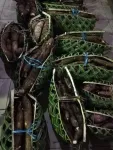(Press-News.org) CAMBRIDGE, MA -- The human eye can perceive about 1 million colors, but languages have far fewer words to describe those colors. So-called basic color terms, single color words used frequently by speakers of a given language, are often employed to gauge how languages differ in their handling of color. Languages spoken in industrialized nations such as the United States, for example, tend to have about a dozen basic color terms, while languages spoken by more isolated populations often have fewer.
However, the way that a language divides up color space can be influenced by contact with other languages, according to a new study from MIT.
Among members of the Tsimane’ society, who live in a remote part of the Bolivian Amazon rainforest, the researchers found that those who had learned Spanish as a second language began to classify colors into more words, making color distinctions that are not commonly used by Tsimane’ who are monolingual.
In the most striking finding, Tsimane’ who were bilingual began using two different words to describe blue and green, which monolingual Tsimane’ speakers do not typically do. And, instead of borrowing Spanish words for blue and green, they repurposed words from their own language to describe those colors.
“Learning a second language enables you to understand these concepts that you didn’t have in your first language,” says Edward Gibson, an MIT professor of brain and cognitive sciences and the senior author of the study. “What’s also interesting is they used their own Tsimane’ terms to start dividing up the color space more like Spanish does.”
The researchers also found that the bilingual Tsimane’ became more precise in describing colors such as yellow and red, which monolingual speakers tend to use to encompass many shades beyond what a Spanish or English speaker would include.
“It’s a great example of one of the main benefits of learning a second language, which is that you open a different worldview and different concepts that then you can import to your native language,” says Saima Malik-Moraleda, a graduate student in the Speech and Hearing Bioscience and Technology Program at Harvard University and the lead author of the study.
Kyle Mahowald, an assistant professor of linguistics at the University of Texas at Austin, and Bevil Conway, a senior investigator at the National Eye Institute, are also authors of the paper, which appears this week in Psychological Science.
Dividing up the color space
In English and many other languages of industrialized nations, there are basic color words corresponding to black, white, red, orange, yellow, green, blue, purple, brown, pink, and gray. South American Spanish additionally divides the blue space into light blue (“celeste”) and dark blue (“azul”).
Members of Tsimane’ society consistently use only three color words, which correspond to black, white, and red. There are also a handful of words that encompass many shades of yellow or brown, as well as two words that are used interchangeably to mean either green or blue. However, these words are not used by everyone in the population.
Several years ago, Gibson and others reported that in a study of more than 100 languages, including Tsimane’, speakers tend to divide the “warm” part of the color spectrum into more color words than the “cooler” regions, which include blue and green. In the Tsimane’ language, two words, “shandyes” and “yushñus,” are used interchangeably for any hue that falls within blue or green.
As a follow-up to that study, Malik-Moraleda wanted to explore whether learning a second language would have any effect on how the Tsimane’ use color words. Today, many Tsimane’ learn Bolivian Spanish as a second language.
Working with monolingual and bilingual members of the Tsimane’, the researchers asked people to perform two different tasks. For the bilingual population, they asked them to do the tasks twice, once in Tsimane’ and once in Spanish.
In the first task, the researchers showed the subjects 84 chips of different colors, one by one, and asked them what word they would use to describe the color. In the second task, the subjects were shown the entire set of chips and asked to group the chips by color word.
The researchers found that when performing this task in Spanish, the bilingual Tsimane’ classified colors into the traditional color words of the Spanish language. Additionally, the bilingual speakers were much more precise about naming colors when they were performed the task in their native language.
“Remarkably, the bilinguals really divide up the space much more than the monolinguals, in spite of the fact that they’re still primarily Tsimane’ speakers,” Gibson says.
Strikingly, the bilingual Tsimane’ also began using separate words for blue and green, even though their native language does not distinguish those colors. Bilingual Tsimane’ speakers began to use “yushñus” exclusively to describe blue, and “shandyes” exclusively to describe green.
Borrowing concepts
The findings suggest that contact between languages can influence how people think about concepts such as color, the researchers say.
“It does seem like the concepts are being borrowed from Spanish,” Gibson says. “The bilingual speakers learn a different way to divide up the color space, which is pretty useful if you’re dealing with the industrialized world. It’s useful to be able to label colors that way, and somehow they import some of that into the Tsimane’ meaning space.”
While the researchers observed that the distinctions between blue and green appeared only in Tsimane’ who had learned Spanish, they say it’s possible that this usage could spread within the population so that monolingual Tsimane’ also start to use it. Another possibility, which they believe is more likely, is that more of the population will become bilingual, as they have more contact with the Spanish-speaking villages nearby.
“Over time, these populations tend to learn whatever the dominant outside language is because it’s valuable for getting jobs where you earn money,” Gibson says.
The researchers now hope to study whether other concepts, such as frames of reference for time, may spread from Spanish to Tsimane’ speakers who become bilingual. Malik-Moraleda also hopes to see if the color language findings from this study could be replicated in other remote populations, specifically, in the Gujjar, a nomadic community living in the Himalayan mountains in Kashmir.
###
The research was funded by a La Caixa Fellowship, the Dingwall Foundation, the Intramural Research Program of the National Eye Institute, and the National Science Foundation CompCog Program.
END
How “blue” and “green” appeared in a language that didn’t have words for them
People of a remote Amazonian society who learned Spanish as a second language began to interpret colors in a new way, an MIT study has found
2023-11-02
ELSE PRESS RELEASES FROM THIS DATE:
Plant populations in Cologne are adapted to their urban environments
2023-11-02
A research team from the Universities of Cologne and Potsdam and the Max Planck Institute for Plant Breeding Research has found that the regional lines of the thale cress (Arabidopsis thaliana), a small ruderal plant which populates the streets of Cologne, vary greatly in typical life cycle characteristics, such as the regulation of flowering and germination. This allows them to adapt their reproduction to local environmental conditions such as temperature and human disturbances. The researchers from Collaborative Research Center / Transregio 341 “Plant Ecological Genetics” found that environmental ...
Making gluten-free, sorghum-based beers easier to brew and enjoy
2023-11-02
Though beer is a popular drink worldwide, it’s usually made from barley, which leaves those with a gluten allergy or intolerance unable to enjoy the frothy beverage. Sorghum, a naturally gluten-free grain, could be an alternative, but complex preparation steps have hampered its widespread adoption by brewers. Now, researchers reporting the molecular basis behind sorghum brewing in ACS’ Journal of Proteome Research have uncovered an enzyme that could improve the future of sorghum-based beers.
Traditionally, beer brewers start with barley grains, which they malt, mash, ...
Jurassic worlds might be easier to spot than modern Earth
2023-11-02
ITHACA, N.Y. –Things may not have ended well for dinosaurs on Earth, but Cornell University astronomers say the “light fingerprint” of the conditions that enabled them to emerge here provide a crucial missing piece in our search for signs of life on planets orbiting alien stars.
Their analysis of the most recent 540 million years of Earth’s evolution, known as the Phanerozoic Eon, finds that telescopes could better detect potential chemical signatures of life in the atmosphere of an Earth-like exoplanet more closely resembling the age the dinosaurs inhabited than the ...
Archaeology: Larger-scale warfare may have occurred in Europe 1,000 years earlier
2023-11-02
A re-analysis of more than 300 sets of 5,000-year-old skeletal remains excavated from a site in Spain suggests that many of the individuals may have been casualties of the earliest period of warfare in Europe, occurring over 1,000 years before the previous earliest known larger-scale conflict in the region. The study, published in Scientific Reports, indicates that both the number of injured individuals and the disproportionately high percentage of males affected suggest that the injuries resulted from a period of conflict, potentially lasting at least months.
Conflict during the European Neolithic period (approximately 9,000 ...
Study warns API restrictions by social media platforms threaten research
2023-11-02
University researchers from the UK, Germany and South Africa warn of a threat to scientific knowledge and the future of research in a paper published in Nature Human Behaviour, outlining the implications of changes to social media Application Programming Interfaces (APIs).
Over the course of 2023, numerous social media platforms including X, TikTok, and Reddit made substantial changes to their APIs – drastically reducing access or increasing charges for access, which the researchers say will in many cases make research harder.
APIs have been routinely tapped by researchers ...
Researchers engineer colloidal quasicrystals using DNA-modified building blocks
2023-11-02
Evanston, IL. --- A team of researchers from the Mirkin Group at Northwestern University’s International Institute for Nanotechnology in collaboration with the University of Michigan and the Center for Cooperative Research in Biomaterials- CIC biomaGUNE, unveils a novel methodology to engineer colloidal quasicrystals using DNA-modified building blocks. Their study will be published in the journal Nature Materials under the title "Colloidal Quasicrystals Engineered with DNA."
Characterized ...
Nanoparticle quasicrystal constructed with DNA
2023-11-02
Images
Nanoengineers have created a quasicrystal—a scientifically intriguing and technologically promising material structure—from nanoparticles using DNA, the molecule that encodes life.
The team, led by researchers at Northwestern University, the University of Michigan and the Center for Cooperative Research in Biomaterials in San Sebastian, Spain, reports the results in Nature Materials.
Unlike ordinary crystals, which are defined by a repeating structure, the patterns in quasicrystals don't repeat. Quasicrystals built from atoms can have exceptional properties—for ...
Damaging thunderstorm winds increasing in central U.S.
2023-11-02
Destructive winds that flow out of thunderstorms in the central United States are becoming more widespread with warming temperatures, according to new research by the U.S. National Science Foundation (NSF) National Center for Atmospheric Research (NCAR).
The new study, published this week in Nature Climate Change, shows that the central U.S. experienced a fivefold increase in the geographic area affected by damaging thunderstorm straight line winds in the past 40 years. The research uses a combination of meteorological observations, very high-resolution computer modeling, and analyses of fundamental ...
Climate-induced loss is impeding human rights in the Pacific
2023-11-02
Climate change is impeding the human rights of a large group of people living in the Pacific, a recent report in Nature reveals.
The paper substantiates a submission to the International Court of Justice (ICJ) on the legal responsibility of countries to act on climate change.
Evidence gathered in Vanuatu supports a clarification on loss and damage finance which could activate powerful legal tools to hold polluters accountable.
Research Fellow at the Griffith University Climate Action Beacon, Dr Ross Westoby said the report explores how climate-induced loss and damage in the Pacific is already occurring and outlines ...
Bartering light for light: scientists discover new system to control the chaotic behavior of light
2023-11-02
NEW YORK, November 2, 2023 — Harnessing and controlling light is vital for the development of technology, including energy harvesting, computation, communications, and biomedical sensing. Yet, in real-world scenarios, complexity in light's behavior poses challenges for its efficient control. Physicist Andrea Alù likens the behavior of light in chaotic systems to the initial break shot in a game of billiards.
“In billiards, tiny variations in the way you launch the cue ball will lead to different patterns of the balls bouncing around the table,” said Alù, Einstein ...
LAST 30 PRESS RELEASES:
Scientists use ultrasound to soften and treat cancer tumors without damaging healthy tissue
Community swimming program for Black youth boosts skills, sense of belonging, study finds
Specific depressive symptoms in midlife linked to increased dementia risk
An ‘illuminating’ design sheds light on cholesterol
Who is more likely to get long COVID?
Study showcases resilience and rapid growth of “living rocks”
Naval Research Lab diver earns Office of Naval Research 2025 Sailor of the Year
New Mayo-led study establishes practical definition for rapidly progressive dementia
Fossil fuel industry’s “climate false solutions” reinforce its power and aggravate environmental injustice
Researchers reveal bias in a widely used measure of algorithm performance
Alcohol causes cancer. A study from IOCB Prague confirms damage to DNA and shows how cells defend against it
Hidden viruses in wastewater treatment may shape public health risks, study finds
Unlock the power of nature: how biomass can transform climate mitigation
Biochar reshapes hidden soil microbes that capture carbon dioxide in farmland
Reducing saturated fat intake shows mortality benefit, but only in high-risk individuals
Manta rays create mobile ecosystems, study finds
Study: Mixed results in using lipoic acid to treat progressive multiple sclerosis
Norbert Holtkamp appointed director of Fermi National Accelerator Laboratory
New agentic AI platform accelerates advanced optics design
Biologists discover neurons use physical signals — not electricity — to stabilize communication
Researchers discover that a hormone can access the brain by hitchhiking
University of Oklahoma researcher awarded funding to pursue AI-powered material design
Exploring how the visual system recovers following injury
Support for parents with infants at pediatric check-ups leads to better reading and math skills in elementary school
Kids’ behavioral health is a growing share of family health costs
Day & night: Cancer disrupts the brain’s natural rhythm
COVID-19 vaccination significantly reduces risk to pregnant women and baby
The role of vaccination in maternal and perinatal outcomes associated with COVID-19 in pregnancy
Mayo Clinic smartwatch system helps parents shorten and defuse children's severe tantrums early
Behavioral health spending spikes to 40% of all children’s health expenditures, nearly doubling in a decade
[Press-News.org] How “blue” and “green” appeared in a language that didn’t have words for themPeople of a remote Amazonian society who learned Spanish as a second language began to interpret colors in a new way, an MIT study has found


